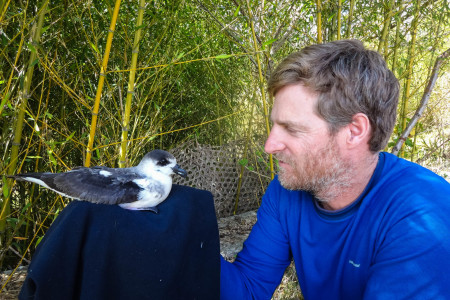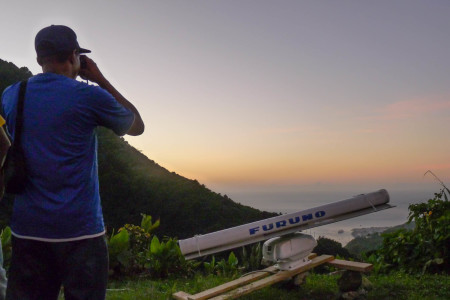
A team of scientists from EPIC and Dominica’s Ministry of Agriculture and Fisheries have recorded 968 Diablotin, also known as the Black-capped Petrel, over the mountains of Dominica, a Lesser Antilles island for which the last confirmed date of nesting of that species is 1862. This rare seabird was once abundant on Dominica, but thought to be extirpated in the late 1800s due to overhunting and the introduction of mammalian species. Observations made with radar and supplemented by detection of vocalizations showed large numbers of petrels flying between the sea and potential nest areas in the island’s highest peaks. Details of the expedition are being released at the 20th International Meeting of BirdsCaribbean, taking place now in Kingston, Jamaica.
Adam Brown, Co-Founder and Lead Scientist at EPIC states, “Finding this colony of petrels on Dominica is a real game-changer for Black-capped Petrel conservation. For years we thought the only remaining colonies of petrels were on Hispaniola, where nesting habitat is diminishing at an alarming rate and pressures of human activity are significant. Dominica is an island-nation where nature conservation is a high priority and forests needed by petrels are well protected, so we now have a huge new opportunity to undertake conservation efforts to preserve this imperiled species.”
Biologists from EPIC and the Forestry, Wildlife and Parks Division of Dominica’s environmental ministry teamed up in January 2015 to do a systematic survey of the entire island of Dominica to locate Diablotin and determine its status. The Diablotin is a very difficult bird to study, as it is a seabird that comes to shore only for a few months of the year to breed, flying into forested mountains at night to underground burrows. A portable marine radar array and night vision scopes allowed biologists to locate, identify and count flying petrels in in the dark. This technique was developed and used successfully to study Diablotin on Hispaniola.

The next step is to confirm breeding by locating active nests. The team is confident that petrels observed on Dominica are breeding but the discovery of birds, eggs or chicks in burrows would make their presence a certainty. Biologists will make expeditions into the mountains in early 2016 when breeding petrels are expected to return to Dominica. Dominica’s forests, many pristine due to strong protections, would appear to offer prime nesting habitat to petrels, but also make locating burrows a challenge.
The Diablotin is considered one of the world’s rarest seabirds with an estimate of only 1,000-2,000 pairs remaining, and until recently, known to nest only on the island of Hispaniola (comprising the nations of Haiti and Dominican Republic). Biologists and others, who have formed an International Black-capped Petrel Conservation Group, held out hope that the species persisted on Dominica, buoyed by occasional findings of adult birds on the ground in coastal or inland areas. However, numerous searches to find evidence of nesting of this species on Dominica during the second half of the 20th century were unsuccessful. The dramatic re-discovery of Diablotin on Dominica gives that nation a huge role in securing the future of this species.

Wonderful news! Although I am a herpetologist, I began work on Dominica in 1958 and spent a big chunk of my early life there studying the wildlife there. Of course I heard about the Diablotin and looked for it…. It’s not going to be easy, but go for it!
Thanks for your encouraging words, Skip! How wonderful that you were able to spend time in Dominica studying wildlife – it’s such a spectacular country.
Thanks for your encouraging words Skip! How wonderful that you were able to spend time in Dominica studying wildlife – it’s such a beautiful country!